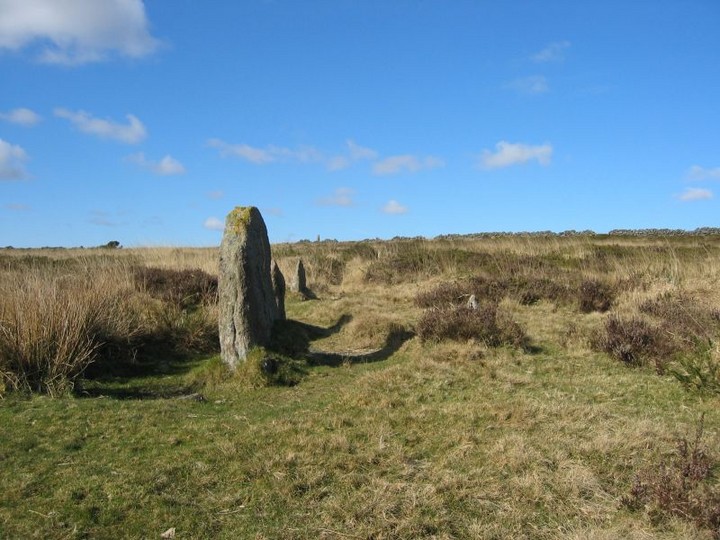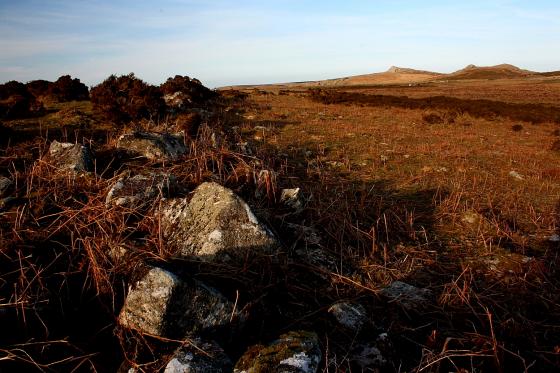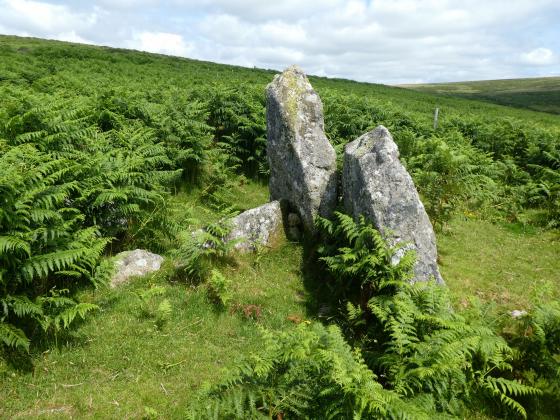
The lower end of the visible stones of the double row.
03/05/2009

The lower end of the visible stones of the double row.
03/05/2009

The visible stones between the Longstone and the wall .
03/05/2009

Looking S.
03/05/2009

Laughter Tor Stone row – 23rd February 2004

Laughter Tor stone row – 23rd Feb 2004

Laughter Tor Standing Stone – 23rd Feb 2004

The Longstone situated at the west end of the stone rows. The photo was taken looking north with Laughter Tor in the back ground.
My guess is that the longstone was the terminal stone of the row, with a cairn circle at it’s end. It reminds me of the Down Tor complex(though different orientation).
There are a couple of big slabs lying around which could have been part of the cairn circle.
The site is best accessed by walking north east from Dunnabridge Pound.The Longstone stands to the west end of a double stone row which has a large area missing from the centre.It stands slightlyout of line to the row and is in the centre of a small cairn.It stands 2.4 metres high.
This silly story sounds like it could apply to Dunnabridge Pound, but the location doesn’t quite tally up. There are quite a few little enclosures in this area, so maybe it refers to one of those instead.
Mounting the steep bank we crossed the road, and passing up by the ruined buildings which were connected with Brimpts Mine, we pointed straight for Loughter Tor. On the slope of this tor, near the summit, is a kind of small cattle pound, an oblong enclosure with high walls, having a gateway on its higher side. It is jocularly reputed to have been constructed as ”a measure for sheep“! Instead of counting the animals they were driven within this enclosure, and as the exact number of sheep it would contain was known, when it was full all trouble of counting was unnecessary, and so it was said the sheep instead of being numbered, were measured!
From ‘Amid Devonia’s Alps’ by William Crossing (1888).
From Tales of the Dartmoor Pixies by William Crossing [1890]. online at sacred-texts.com/neu/eng/tdp
The following was told me by old George Caunter, of Dartmeet (Uncle George)..
A man named Hannaford, together with his wife, once lived at Lough Tor Hole*, which is situated on the East Dart, at no great distance below Bellaford Bridge. The few dwellers in the neighbourhood had often heard them speak of their children, but no one, when chancing to call at the house, had ever seen anything of them there. Sometimes as they approached it a troop of ragged little imps would appear for a moment to their view, and immediately vanish among the bracken as if by magic. Occasionally a farmer or a moor-man seeking his cattle near the place, would see several little forms scrambling among the boulders of granite, but on the slightest attempt to get near them they disappeared.
At length it was hinted among the people round about that what Hannaford and his wife called their children were nothing more nor less than a troop of pixies, for they disappeared in the same extraordinary fashion, on the approach of anyone, that those little elves were said to do. This belief continued to grow, and in a short time there were none who doubted that Hannaford and his wife were connected in some mysterious manner with that tribe of little goblins, and folks began to shun passing that way.
But of witchery there was none, for, as Uncle George explained, Lough Tor Hole is a very out-of-the-way place, and those who visited it but few, and the young children being accustomed to see scarce anyone but their parents became frightened on the approach of a stranger, and hid themselves with all speed, keeping out of the way until they had departed.
* I am not sure as to the correct mode of spelling the name of this place. The tor above it is sometimes rendered Laugh Tor, and sometimes Lough Tor. The old spelling of the name is Lafter Hole, and it is often so pronounced at present on the moor, though more frequently spoken of as Larter Hall
What, now Dartmoor people don’t know the difference between a child and a pixie? Give me a break.





































































































































































































































































































